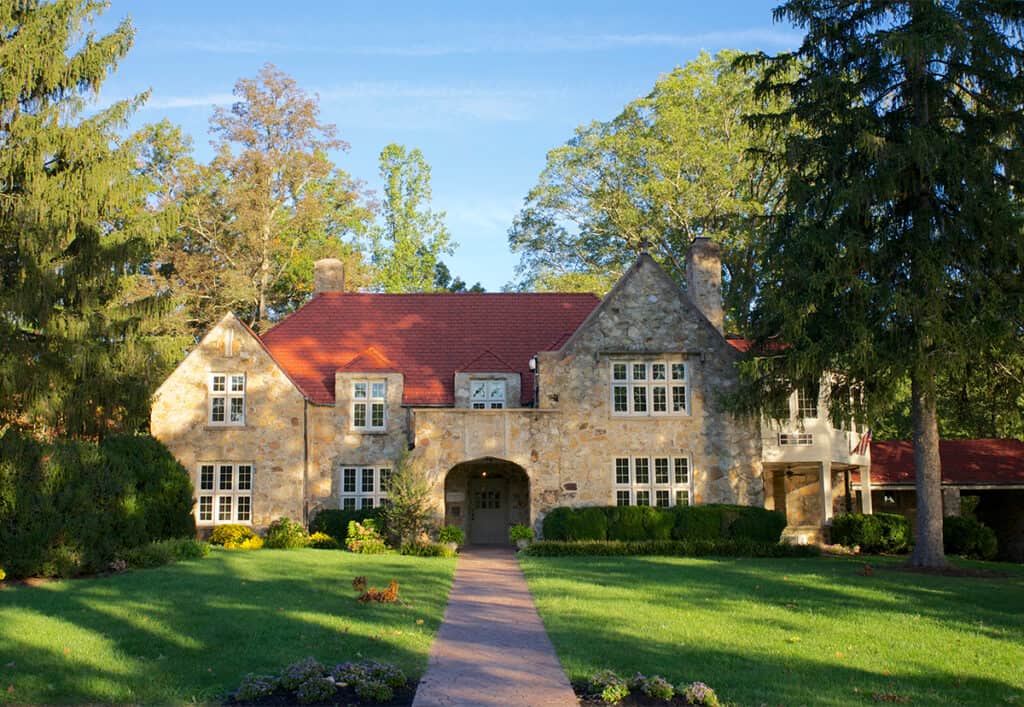 While his son Trey was a student at Blue Ridge in the 80’s, Turley Higgins came to know the Gibson Memorial Chapel organ as one that was played beautifully by Mr. Jim Niederberger. No one seems to know the exact age of the pipe organ. According to the National Register of Historic Places Registration Form signed on March12, 1993, the chapel was completed on the Blue Ridge campus in 1932 with “uncut and uncoursed native fieldstone” and “executed in the English Gothic Revival style.” This document mentions the chapel organ as being “of uncertain date.” The Organ Historical Society database website includes a beautiful photograph of the organ pipes and keyboard, but it also admits not knowing a date of installation.
While his son Trey was a student at Blue Ridge in the 80’s, Turley Higgins came to know the Gibson Memorial Chapel organ as one that was played beautifully by Mr. Jim Niederberger. No one seems to know the exact age of the pipe organ. According to the National Register of Historic Places Registration Form signed on March12, 1993, the chapel was completed on the Blue Ridge campus in 1932 with “uncut and uncoursed native fieldstone” and “executed in the English Gothic Revival style.” This document mentions the chapel organ as being “of uncertain date.” The Organ Historical Society database website includes a beautiful photograph of the organ pipes and keyboard, but it also admits not knowing a date of installation.
Even Mr. Jim Niederberger, the Chapel organist since 1970, admits that some of what he knows about the organ’s origin and history is not documented. An interesting organ tuner by the name of Cleveland Fisher, who lived in Manassas, Virginia, in the sixties and seventies, told Jim the following. The organ was built in 1906 by Henry Pilcher’s Sons in Louisville, Kentucky. There is, in fact, a plate on the organ that identifies its maker but not its date of creation. It was apparently in a church in Charlottesville, Virginia, until it came to be in the Blue Ridge Industrial School Chapel in the late 1930’s. By the time the School opened its doors as all-boys and all-boarding in 1962, the organ was in desperate need of attention.
The Reverend Dudley Boogher, chair of the Board at the time as well as rector of St. Paul’s Episcopal Church in Ivy, Virginia, found that turning point in the School’s history as an excellent moment to breathe new life into the organ. The Board hired Mr. Fisher to “tonally revise and recondition” the instrument and even allowed him to live in Battle House during the several months it took him to do so. The Reverend Boogher donated a Hammond B-3 from St. Paul’s to be used during the old organ’s restoration.
None of this really verifies for sure the age of the organ. But Jim Niederberger knew it was old in the 70’s, and Turley Higgins knew it was even older in the 80’s. That it still produced such a remarkable sound is perhaps a testimony to Mr. Fisher’s tuning talents as well as to Jim’s keyboard skills. Since the 90’s, Mr. Xaver Wilhelmy, a Pipe Organ Builder with Geshenke aus Glas (means Gift of Glass) in Staunton, Virginia, has been the curator of the historic instrument. He visits twice a year to clean the pipes and make other adjustments. Though Jim certainly makes that organ hum during chapel services, no one living today really knows the inner workings of this particular organ better than does Mr. Wilhelmy.
DISASSEMBLING THE ORGAN:
The organ had to be disassembled, delivered to Buck Mountain and put back together. This was no small order. Having already been identified as a consultant, Mr. Wilhelmy was also secured to complete this delicate work. He’s quite humble about his extensive credentials. One must view the Geshenke aus Glas website, which he doesn’t mention, to learn that he has built pipe organs from scratch and has renovated instruments in homes and churches as well as concert halls in Europe and the US, including the Old Post Office Chapel at the Arlington National Cemetery. Having trained at Rieger Orgelbau with Master Organ Builder Casper Glatter-Goetz in Austria, he has learned the ancient fine art and craft of pipe organ building in the classical style with voicing being his specialty. Both Blue Ridge School and Buck Mountain Episcopal Church are quite fortunate that Mr. Wilhelmy will be completing the operation.
He lists the intricate process as including the following:
- Disassembly of the instrument inclusive of cleaning all pipes and parts as we take it apart and carefully pack the pipes and small components into wooden crates.
- Transfer of the organ into climate-controlled storage for a minimum of three months with the large organ components (wind chests, bellows) opened up for even acclimatization.
- Repair of any cracks that are present or develop during storage, plus replacement of internal tracker linkages that have aged prematurely.
- Design and manufacture of a partial case with access door for the left side of the instrument, which otherwise would be exposed in the new location.
- Lowering the elevation of the front pipes to fit beneath the ceiling at Buck Mountain Church.
- Installation of the instrument from the ground up on newly leveled sub-frame.
- Fitting of a new organ blower.
- Technical adjustment of the tracker action inclusive of coupler system.
- Voicing adjustments for the organ to fit the new space tonally, and tuning of the instrument.
- Mr. Wilhelmy was excited about being a part of this transfer as he, too, saw the value in once again breathing new life into an historical instrument just as Cleveland Fisher, under the direction of the Reverend Dudley Boogher, did in 1962. Mr. Wilhelmy has cared for the instrument for many years, himself, and was fastidious in delivering it to Buck Mountain.
(An excerpt from an article in The Ridge, Fall 2016 by Mr. Dan Dunsmore.)




